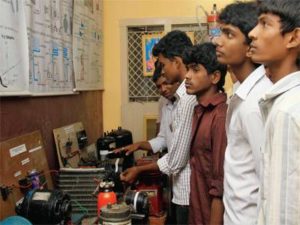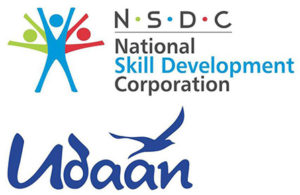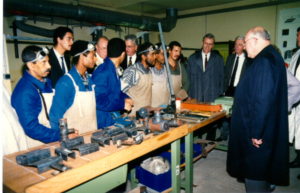 Yes, there is a drive going on around the world for skill development. There are international forums, non-governmental organisations and multi-national corporations working on the skill upgrade requirements. Most of it has been triggered by the technological improvements but also by the lack of standard training methodology. There are many sectors where there is a crunch of trained manpower and they have to depend on hiring the skilled resources from other countries. The Indian government also found an awning gap in the availability of the skilled manpower in a number of industrial sectors.
Yes, there is a drive going on around the world for skill development. There are international forums, non-governmental organisations and multi-national corporations working on the skill upgrade requirements. Most of it has been triggered by the technological improvements but also by the lack of standard training methodology. There are many sectors where there is a crunch of trained manpower and they have to depend on hiring the skilled resources from other countries. The Indian government also found an awning gap in the availability of the skilled manpower in a number of industrial sectors.
 Skilling process: India has a huge population resource and it appears a bit odd when we say that we have a very limited skilled manpower. The major reason for this gap lies in the fact that most of the skill training takes place in the form of “On the Job Training” or OJT in the unorganised sector. The learner picks up a few tricks of the trade from an experienced hand and then ventures into the job or freelance market. He makes mistakes and causes a problem for his clients but stumbles on by hook or crook.
Skilling process: India has a huge population resource and it appears a bit odd when we say that we have a very limited skilled manpower. The major reason for this gap lies in the fact that most of the skill training takes place in the form of “On the Job Training” or OJT in the unorganised sector. The learner picks up a few tricks of the trade from an experienced hand and then ventures into the job or freelance market. He makes mistakes and causes a problem for his clients but stumbles on by hook or crook.
 Organised effort: The government of India understood the problem and set up the National Skill Development Corporation (NSDC), a first of its kind Public Private Partnership (PPP). NSDC is co-promoted by the finance ministry with a mandate to involve the private sector in training 150 million people by 2022. It has set up 28 sector skill councils (SSC) across verticals like Electronics, Plumbing etc.
Organised effort: The government of India understood the problem and set up the National Skill Development Corporation (NSDC), a first of its kind Public Private Partnership (PPP). NSDC is co-promoted by the finance ministry with a mandate to involve the private sector in training 150 million people by 2022. It has set up 28 sector skill councils (SSC) across verticals like Electronics, Plumbing etc.
 Qualification framework: In the end of 2013 the government established National Skills Qualification Framework (NSQF) through a gazette notification. This was done to allow the skill development initiatives to be stitched together. NSQF is an outcome based 10 level framework designed to implement all skill development initiatives in alignment with the qualification packs (QPs), which are standards laid down by the industry through SSCs for each job role in the sector.
Qualification framework: In the end of 2013 the government established National Skills Qualification Framework (NSQF) through a gazette notification. This was done to allow the skill development initiatives to be stitched together. NSQF is an outcome based 10 level framework designed to implement all skill development initiatives in alignment with the qualification packs (QPs), which are standards laid down by the industry through SSCs for each job role in the sector.
 The gap in the two streams: If you look at the education system in India you will find a split between the general education and vocational education and training verticals. There is hardly any cohesiveness between the two. The rush has always been for the academic excellence and the acquiring degrees and qualifications. The youth has always hesitated in making vocational education and training as his choice. The NSQF platform will facilitate mobility from vocational to general education and vice versa.
The gap in the two streams: If you look at the education system in India you will find a split between the general education and vocational education and training verticals. There is hardly any cohesiveness between the two. The rush has always been for the academic excellence and the acquiring degrees and qualifications. The youth has always hesitated in making vocational education and training as his choice. The NSQF platform will facilitate mobility from vocational to general education and vice versa.
 Methodology: It is possible for the learner to attain the competency certification at the desired level under NSQF, by the use of his learning in a formal or informal manner. Thus, NSQF is a quality assurance framework. Today there are more than 100 countries that are in the process of developing the NSQF. The SSCs will identify the skill development needs and prepare the National Occupational Standards (NOS) and QPs and get them approved under the NSQF.
Methodology: It is possible for the learner to attain the competency certification at the desired level under NSQF, by the use of his learning in a formal or informal manner. Thus, NSQF is a quality assurance framework. Today there are more than 100 countries that are in the process of developing the NSQF. The SSCs will identify the skill development needs and prepare the National Occupational Standards (NOS) and QPs and get them approved under the NSQF.
 Definition: NOS specifies the standard of performance an individual must achieve when carrying out a function in a workplace, together with the knowledge and understanding they need to meet the standard consistently. The NOS development cycle ensures the industry engagement through the SSC. QP captures the requirement of a job role in a designated position in a department of the industry. The QP is a compilation of multiple NOSs, which function as building blocks accumulating the tasks that need to be performed under that job role.
Definition: NOS specifies the standard of performance an individual must achieve when carrying out a function in a workplace, together with the knowledge and understanding they need to meet the standard consistently. The NOS development cycle ensures the industry engagement through the SSC. QP captures the requirement of a job role in a designated position in a department of the industry. The QP is a compilation of multiple NOSs, which function as building blocks accumulating the tasks that need to be performed under that job role.
 The NSDC is a well-organised effort and the citizens of the country must avail the opportunity to improve their vocational skills. It also recognises your prior learning and allows you to obtain accreditation by clearing the test. The process is so streamlined that it will lead you towards sure shot employment based on a certification by an approved agency.
The NSDC is a well-organised effort and the citizens of the country must avail the opportunity to improve their vocational skills. It also recognises your prior learning and allows you to obtain accreditation by clearing the test. The process is so streamlined that it will lead you towards sure shot employment based on a certification by an approved agency.


Thanks for the information on NSDC. I had read about it somewhere but I did not know that the training is being carried out by it on such a large scale. I have some basic knowledge of electronics and I run a repair business. I was looking for a certification and this looks to be right place to get it at an affordable cost.
After reading this article I was able to guide the carpenter working at my home to go in for the NSDC training. He had learned it from someone but was not very happy about the extent of his knowledge. I think more people should utilize this opportunity as it does not cost anything except a time of around 45 days for training.
Out of the variety of skill development programs that are available today, this one by NSDC seems to be very effective as there is a surety of employment after the short duration training program. I must appreciate the effort being put in by the PPPs.